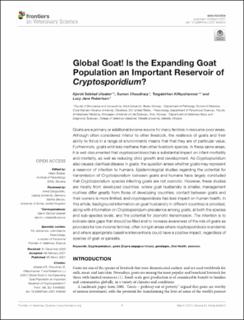| dc.contributor.author | Utaaker, Kjersti Selstad | |
| dc.contributor.author | Chaudhary, Suman | |
| dc.contributor.author | Kifleyohannes, Tsegabirhan | |
| dc.contributor.author | Robertson, Lucy Jane | |
| dc.date.accessioned | 2021-09-27T10:57:33Z | |
| dc.date.available | 2021-09-27T10:57:33Z | |
| dc.date.created | 2021-04-10T13:55:15Z | |
| dc.date.issued | 2021 | |
| dc.identifier.citation | Utaaker, K. S., Chaudhary, S., Kifleyohannes, T. & Robertson, L. J. (2021). Global goat! Is the expanding goat population an important reservoir of Cryptosporidium? Frontiers in Veterinary Science, 8: 648500. doi: | en_US |
| dc.identifier.issn | 2297-1769 | |
| dc.identifier.uri | https://hdl.handle.net/11250/2783704 | |
| dc.description.abstract | Goats are a primary or additional income source for many families in resource-poor areas. Although often considered inferior to other livestock, the resilience of goats and their ability to thrive in a range of environments means that that they are of particular value. Furthermore, goats emit less methane than other livestock species. In these same areas, it is well-documented that cryptosporidiosis has a substantial impact on infant morbidity and mortality, as well as reducing child growth and development. As Cryptosporidium also causes diarrheal disease in goats, the question arises whether goats may represent a reservoir of infection to humans. Epidemiological studies regarding the potential for transmission of Cryptosporidium between goats and humans have largely concluded that Cryptosporidium species infecting goats are not zoonotic. However, these studies are mostly from developed countries, where goat husbandry is smaller, management routines differ greatly from those of developing countries, contact between goats and their owners is more limited, and cryptosporidiosis has less impact on human health. In this article, background information on goat husbandry in different countries is provided, along with information on Cryptosporidium prevalence among goats, at both the species and sub-species levels, and the potential for zoonotic transmission. The intention is to indicate data gaps that should be filled and to increase awareness of the role of goats as providers for low-income families, often living in areas where cryptosporidiosis is endemic and where appropriate baseline interventions could have a positive impact, regardless of species of goat or parasite. | en_US |
| dc.language.iso | eng | en_US |
| dc.publisher | Frontiers | en_US |
| dc.rights | Navngivelse 4.0 Internasjonal | * |
| dc.rights.uri | http://creativecommons.org/licenses/by/4.0/deed.no | * |
| dc.title | Global goat! Is the expanding goat population an important reservoir of Cryptosporidium? | en_US |
| dc.type | Peer reviewed | en_US |
| dc.type | Journal article | en_US |
| dc.description.version | publishedVersion | en_US |
| dc.rights.holder | © 2021 The Author(s) | en_US |
| dc.subject.nsi | VDP::Landbruks- og Fiskerifag: 900::Klinisk veterinærmedisinske fag: 950 | en_US |
| dc.subject.nsi | VDP::Matematikk og Naturvitenskap: 400::Basale biofag: 470::Genetikk og genomikk: 474 | en_US |
| dc.subject.nsi | VDP::Landbruks- og Fiskerifag: 900::Landbruksfag: 910::Husdyravl, oppdrett, forplantning: 912 | en_US |
| dc.source.pagenumber | 11 | en_US |
| dc.source.volume | 8 | en_US |
| dc.source.journal | Frontiers in Veterinary Science | en_US |
| dc.identifier.doi | 10.3389/fvets.2021.648500 | |
| dc.identifier.cristin | 1903336 | |
| dc.source.articlenumber | 648500 | en_US |

